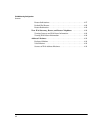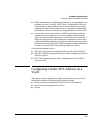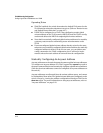
4-10
IPv6 Addressing Configuration
Enabling DHCPv6
To view the current IPv6 DHCPv6 settings per-VLAN, use show run.
To view all currently configured IPv6 unicast addresses, use the following:
■ show ipv6 (Lists IPv6 addresses for all VLANs configured on the switch.)
■ show ipv6 vlan < vid > (Lists IPv6 addresses configured on the VLAN.)
For more information, refer to “View the Current IPv6 Addressing Configura-
tion” on page 4-21.
Operating Notes
■ If multiple DHCPv6 servers are available, the switch selects a server based
on the preference value sent in DHCPv6 messages from the servers.
■ The switch supports both DHCPv4 and DHCPv6 client operation on the
same VLAN.
■ DHCPv6 authentication and stateless DHCPv6 are not supported in soft-
ware release K.13.01.
■ With IPv6 enabled, the switch determines the default IPv6 router for the
VLAN from the router advertisements it receives. (Refer to “Default IPv6
Router” on page 4-28.)
— Continued from the previous page. —
After verification of uniqueness by DAD, an IPv6 address
assigned to the VLAN by an DHCPv6 server is set to the
preferred and valid lifetimes specified in a router advertise-
ment received on the VLAN for the prefix used in the assigned
address, and is configured as a preferred address. (Refer to
the section titled “Address Lifetimes” on page 4-32.)
[rapid-commit]: Expedites DHCP configuration by using a two-
message exchange with the server (solicit-reply) instead of the
default four-message exchange (solicit-advertise- request-
reply).
Default: Disabled
The no form of the command removes the DHCPv6 option from
the configuration and, if no other IPv6-enabling command is
configured on the VLAN, disables IPv6 on the VLAN. (Refer to
“Disabling IPv6 on a VLAN” on page 4-16.)


















